Matcha is no longer a niche product—it has become a global trend in cafés, retail, food manufacturing, and nutraceuticals. But when international buyers approach suppliers, one of the first questions is always: “Why do prices vary so much?” Some matcha powders are quoted at very affordable levels, while others are several times higher. Understanding the cost structure behind wholesale matcha helps importers, distributors, and retailers choose the right grade, negotiate effectively, and plan their supply chain. Below we break down 10 critical factors that drive matcha pricing in the B2B market.
1. Origin of the Tea
The place where matcha is grown and produced is one of the strongest price indicators. Climate, soil, production history, and branding all contribute to the final cost.
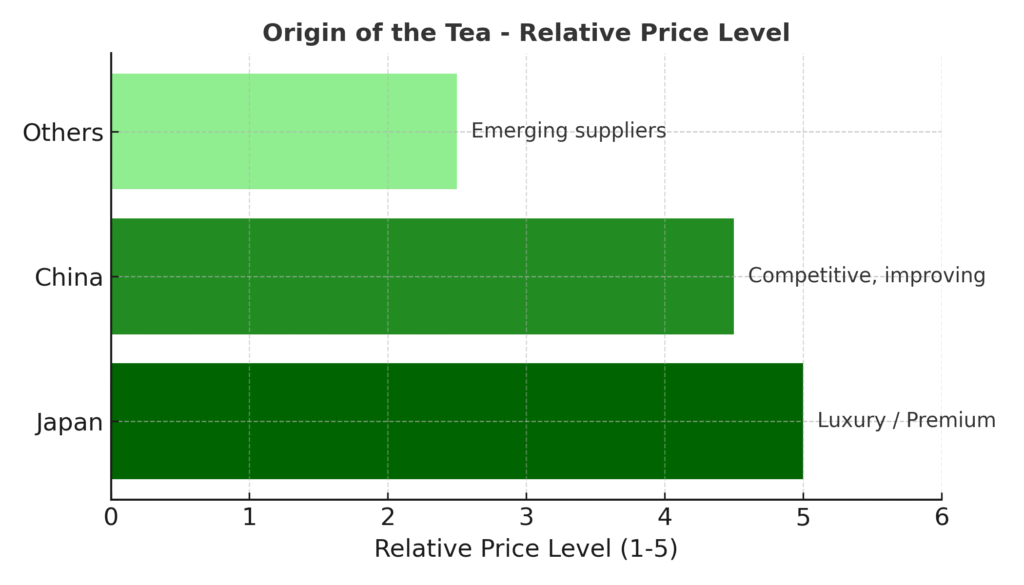
| Origin | Relative Price Level | Key Features | Market Perception |
|---|---|---|---|
| Japan | Very High (5/5) | Long heritage, limited production | Luxury / Premium image |
| China | Medium–High (4–5/5) | Wide range, scaling up rapidly | Competitive, improving quality |
| Others (Taiwan, Kenya) | Low–Medium (2–3/5) | Small scale, niche products | Emerging suppliers |
Buyer Question: “Is Japanese matcha always better?”
Answer: Not necessarily. Japan benefits from branding and heritage, but China’s high-grade matcha (especially from Guizhou and Zhejiang) is now on par with many Japanese ceremonial grades, often at a lower cost.
2. Tea Cultivar
The variety of tea plant affects the taste, aroma, and price of matcha. Some cultivars are high-yield and common, while others are rare and labor-intensive.
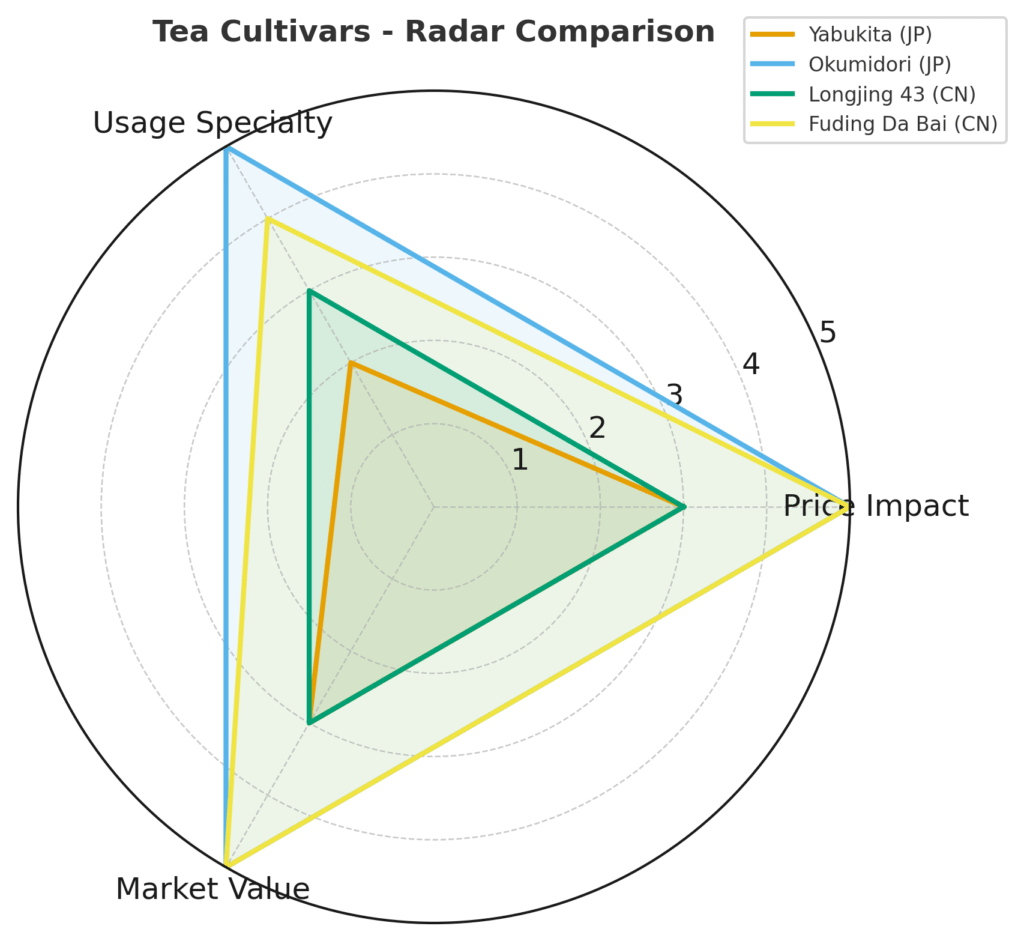
| Cultivar | Typical Use | Relative Price Impact | Notes |
|---|---|---|---|
| Yabukita (JP) | General purpose | Medium | Widely used in Japan |
| Okumidori (JP) | Premium/Ceremonial | High | Vivid green, mild taste |
| Longjing 43 (CN) | Culinary/Premium | Medium | Stable, large yields |
| Fuding Da Bai (CN) | Ceremonial | High | Smooth taste, bright green |
Buyer Question: “Do cultivars really affect pricing?”
Answer: Yes. Large-scale cultivars (like Yabukita, Longjing 43) keep costs lower, while specialty cultivars (Okumidori, Fuding Da Bai) increase production costs but deliver better color and flavor.
3. Farming Practices
How tea is grown and harvested directly influences cost and quality. Labor-intensive methods usually mean higher prices.
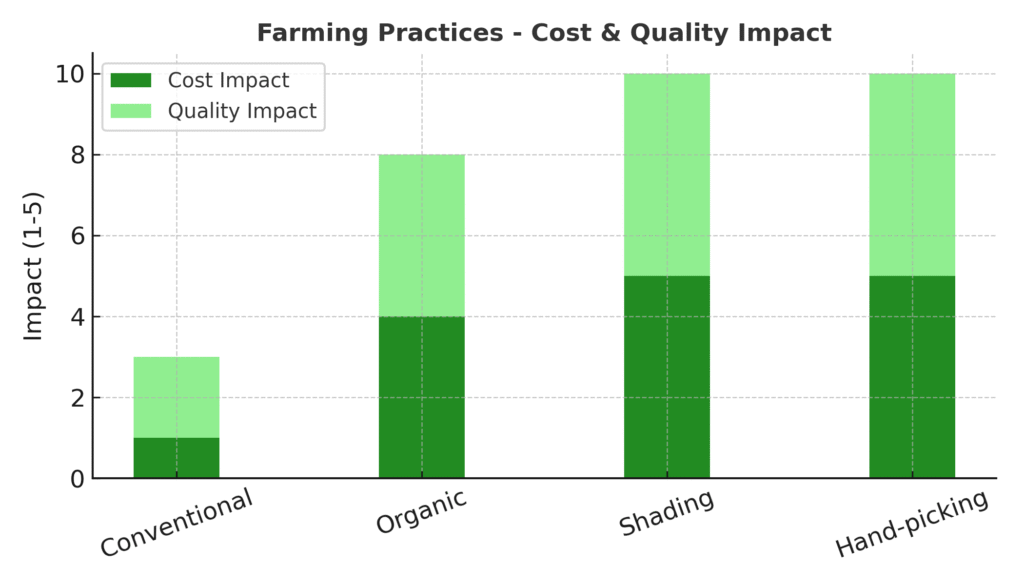
| Practice | Cost Impact | Quality Impact | Market Value |
|---|---|---|---|
| Conventional | Low | Standard | Entry-level |
| Organic | Medium–High | Higher demand | Preferred in exports |
| Shading (20–30 days) | High | Rich umami, bright green | Essential for ceremonial |
| Hand-picking | High | Consistent leaves | Premium batches |
Buyer Question: “Why is organic matcha more expensive?”
Answer: Organic farming avoids chemical inputs, requires certification audits, and increases labor intensity—all of which raise costs.
4. Processing Method
The way leaves are processed—from steaming to grinding—has a huge impact on cost and buyer perception.
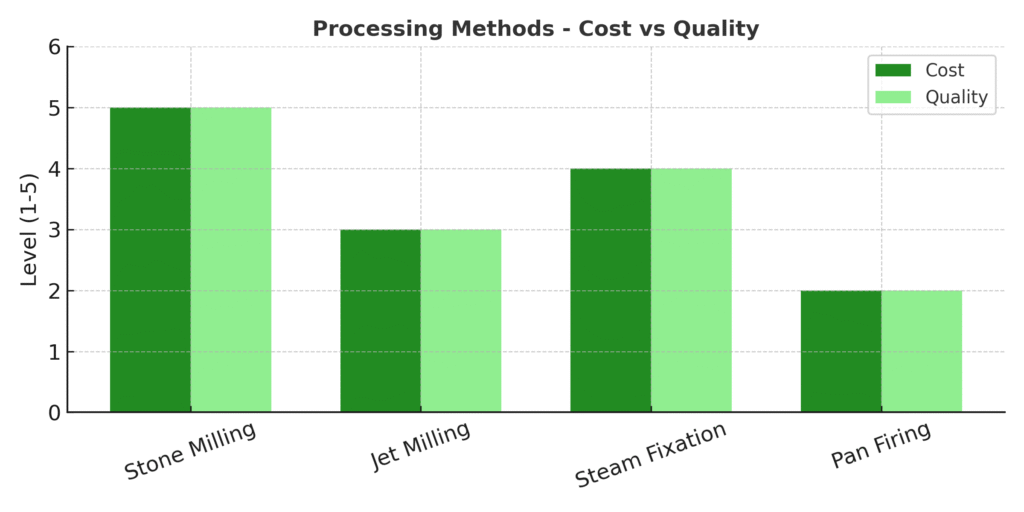
| Method | Cost Level | Product Quality | Buyer Preference |
|---|---|---|---|
| Stone Milling | Very High | Ultra-fine, vibrant green | Premium buyers |
| Jet Milling | Medium | Fine but less vivid | Mid-range buyers |
| Steam Fixation | Medium–High | Retains bright green | Global standard |
| Pan Firing | Low | Yellowish, roasted note | Limited appeal |
Buyer Question: “Is stone-milled matcha worth the cost?”
Answer: Yes, for ceremonial grade. Stone milling creates a finer texture and better mouthfeel that machine milling cannot replicate.
5. Grade and Application
Matcha is priced differently depending on grade and end use.
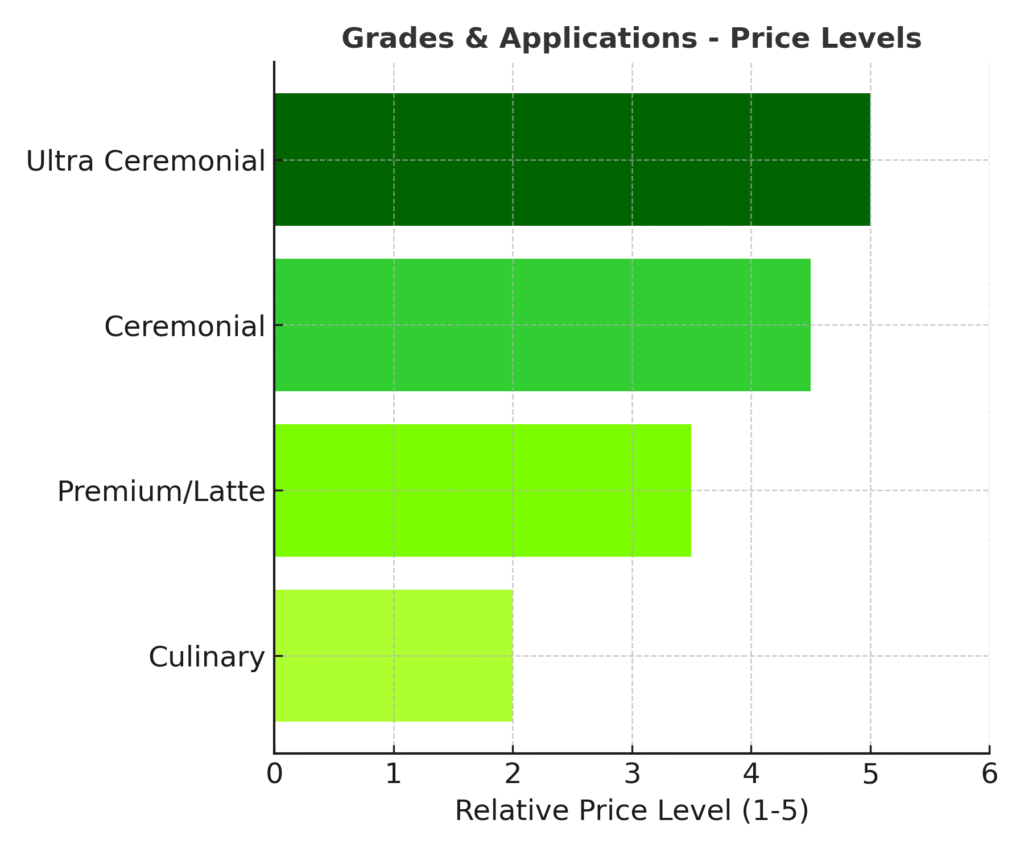
| Grade | Application | Relative Price Level |
|---|---|---|
| Culinary | Bakery, smoothies, food | Low–Medium |
| Premium/Latte | Cafés, bubble tea, beverages | Medium–High |
| Ceremonial | Direct drinking, retail tins | High |
| Ultra Ceremonial | Traditional tea ceremony | Very High |
Buyer Question: “Can I use culinary grade for drinks?”
Answer: Technically yes, but the taste will be more bitter and dull. Most cafés prefer latte grade for balance.
6. Certifications
Compliance and certification add cost but open markets.
| Certification | Required Market | Impact on Cost | Notes |
|---|---|---|---|
| USDA/EU Organic | USA, Europe | Medium–High | Expands retail access |
| Halal | Middle East, Asia | Medium | Mandatory in some markets |
| Kosher | USA, Israel | Medium | Niche but valuable |
| HACCP/ISO22000 | Global | Medium | Food safety compliance |
| FDA Registration | USA | Low–Medium | Import requirement |
Buyer Question: “Can I sell matcha without certification?”
Answer: In some regions yes, but in most export markets at least HACCP or Organic is required for smooth clearance and retail access.
7. Packaging
The choice of packaging changes unit cost significantly.
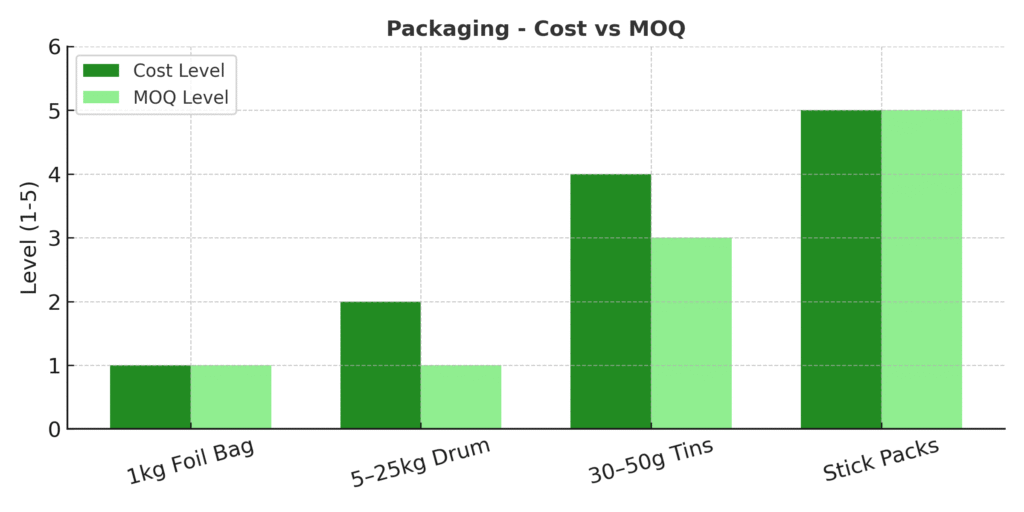
| Packaging Type | MOQ (Typical) | Cost Level | Suitable For |
|---|---|---|---|
| 1kg Foil Bag | 1–5 pcs | Lowest | Bulk buyers, repacking |
| 5–25kg Bags/Drums | 1–2 pcs | Low | Industrial buyers |
| 30–50g Tins | 200+ pcs | Medium–High | Retail brands |
| Stick Packs | 10,000+ pcs | High | On-the-go market |
Buyer Question: “Why are tins more expensive?”
Answer: Small packaging requires more material, labeling, and filling labor. Bulk bags reduce per-unit cost dramatically.
8. Order Size and MOQ
The bigger the order, the lower the per-unit price.
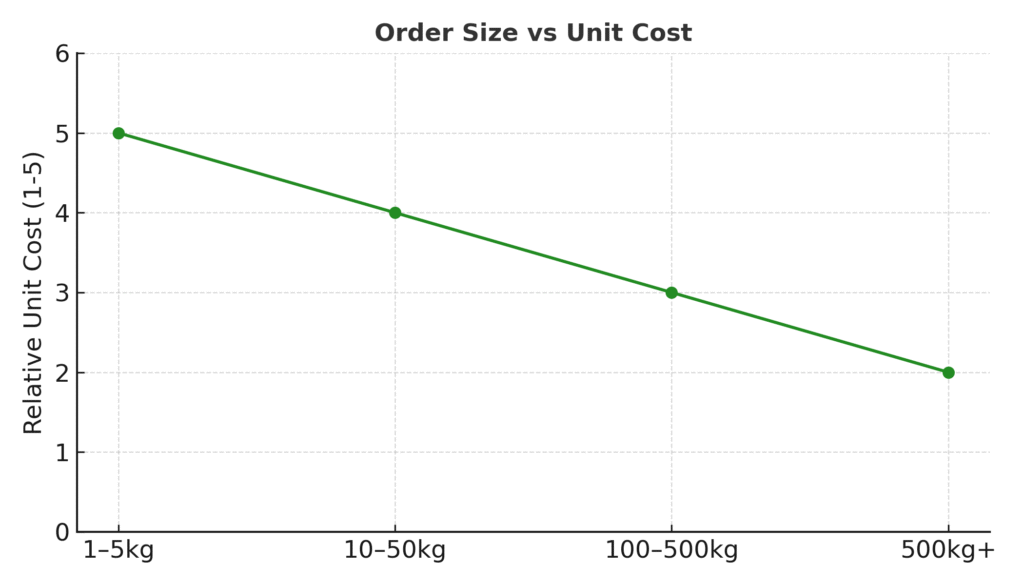
| Order Size | Cost per kg Impact | Typical Buyers |
|---|---|---|
| 1–5 kg | Highest | Testing, cafés |
| 10–50 kg | Lower | Small retailers |
| 100–500 kg | Even lower | Distributors |
| 500 kg+ | Lowest | Importers, factories |
Buyer Question: “Why is my sample order more expensive per kg?”
Answer: Small orders involve the same labor and certification steps as large orders, but without economies of scale.
9. Logistics and Shipping
Shipping method can shift landed cost by 20–30%.
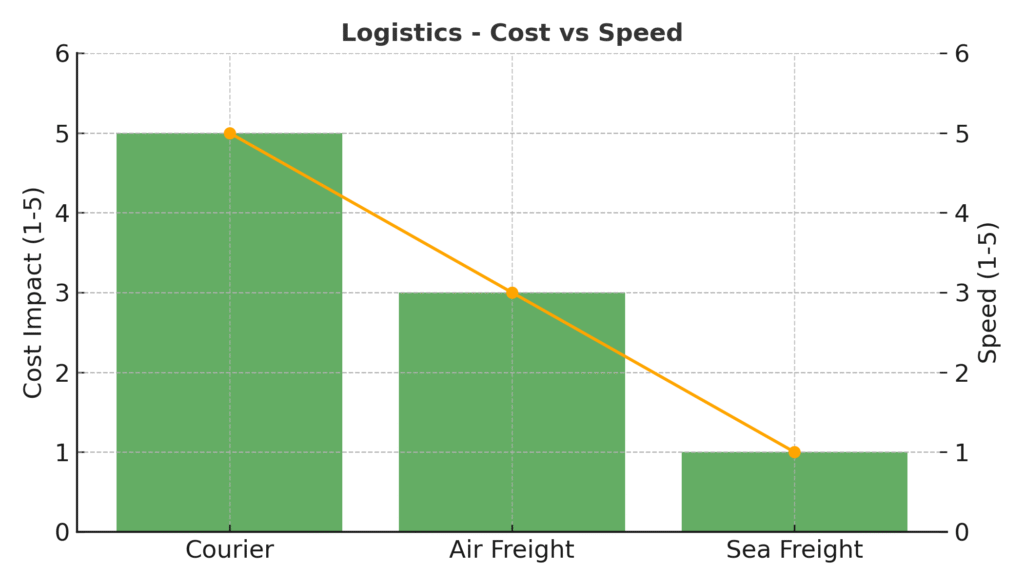
| Method | Cost Impact | Speed | Best For |
|---|---|---|---|
| Courier (DHL/FedEx) | High | Fast (7–10 d) | Samples, small orders |
| Air Freight | Medium | 10–15 days | 20–500 kg |
| Sea Freight | Low | 25–40 days | 500 kg+ |
Buyer Question: “Which shipping is best for me?”
Answer: For samples and urgent orders, courier is fastest. For bulk orders above 100kg, sea freight is most cost-effective.
10. Supplier Experience and Service
Beyond product, supplier reliability also affects pricing.
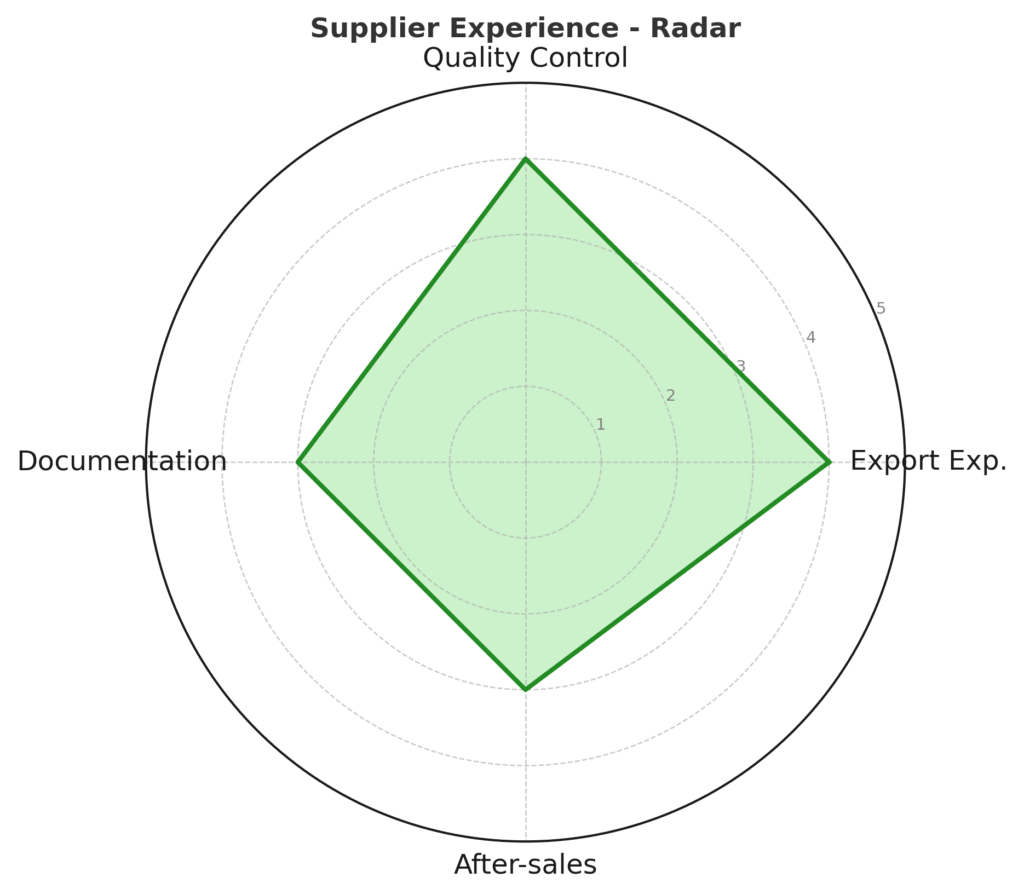
| Factor | Cost Impact | Buyer Benefit |
|---|---|---|
| Export Experience | Medium | Smooth customs clearance |
| Quality Control | Medium | Consistent batches |
| Documentation | Low | Reduced delays |
| After-sales | Low–Medium | Long-term trust |
Buyer Question: “Why pay more for an experienced supplier?”
Answer: Because inexperienced suppliers may cause costly delays, rejected shipments, or inconsistent quality. Paying slightly more reduces long-term risks.
Conclusion
Wholesale matcha pricing is shaped by 10 interconnected factors: origin, cultivar, farming, processing, grade, certifications, packaging, order size, logistics, and supplier experience.
For buyers, the real challenge is not chasing the cheapest quote, but finding a balance between cost, quality, compliance, and supply stability.
